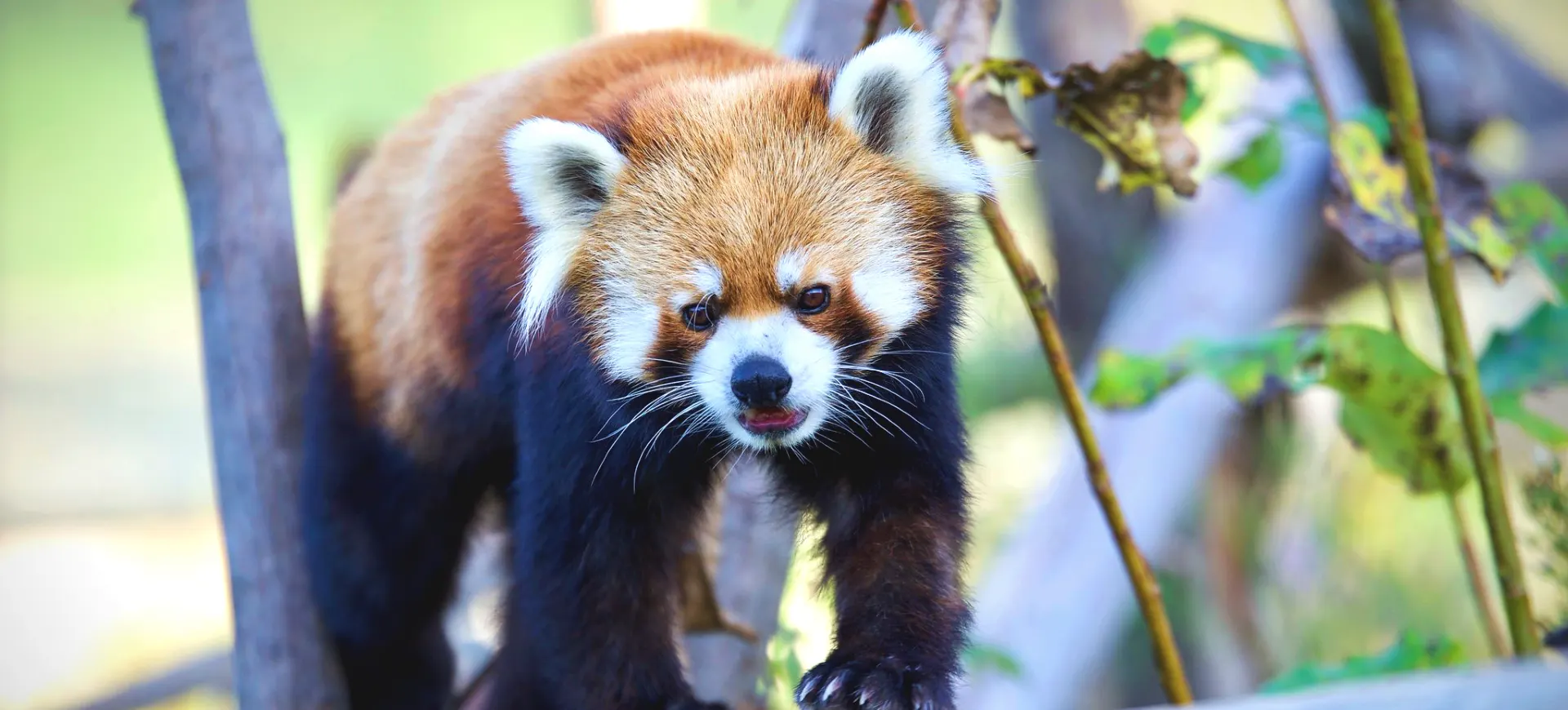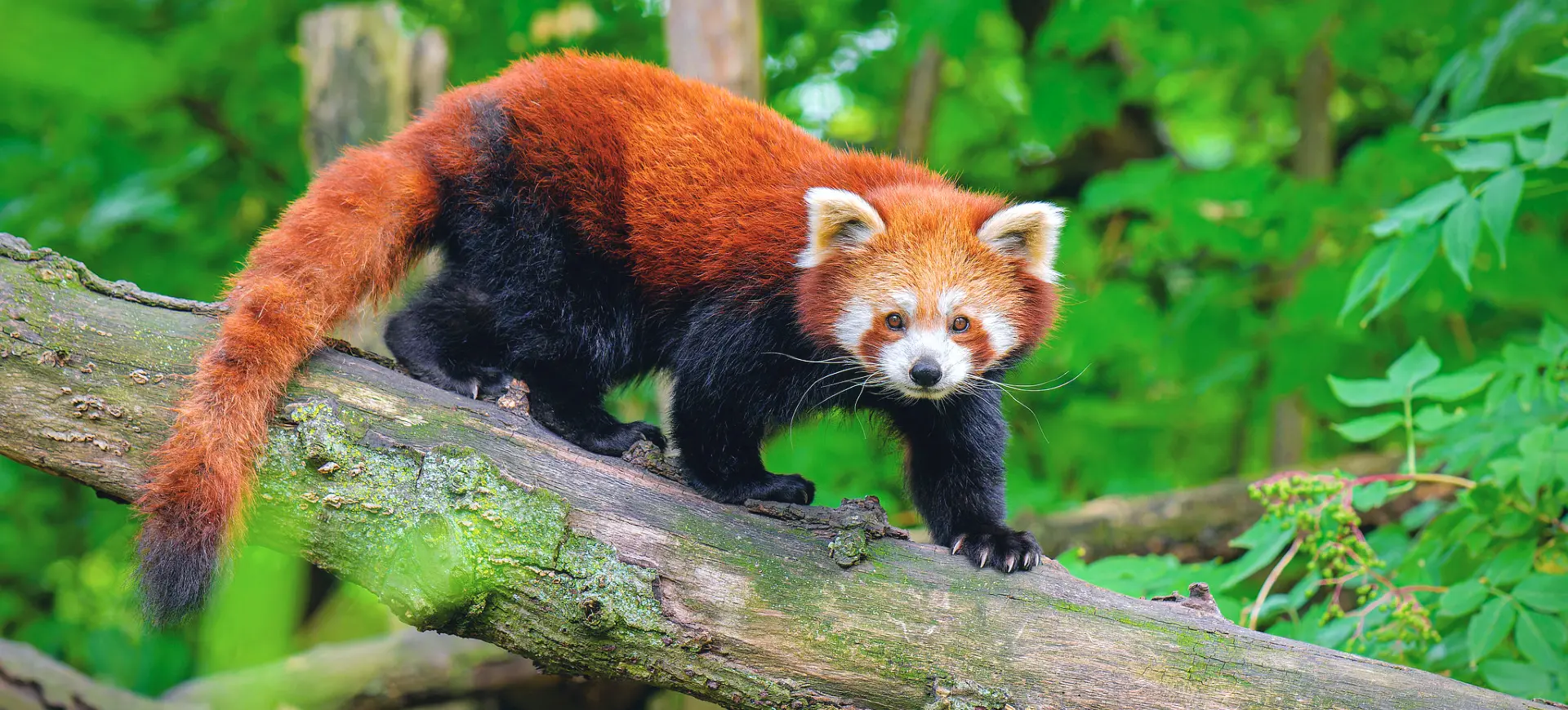Overview
The Red Panda (Ailurus fulgens) is a mammal native to the eastern Himalayas and southwestern China. It is slightly larger than a domestic cat with reddish-brown fur, a long, shaggy tail, and a waddling gait. Despite its name, the Red Panda is not closely related to the giant panda but belongs to its unique family.
Primarily an herbivore, the Red Panda mainly feeds on bamboo but eats eggs, birds, and insects. It is mainly active at night and is largely solitary, communicating with others through body language and a series of different sounds. Red Pandas prefer living in dense forests with old trees and bamboo undergrowth, making them challenging to spot in the wild.
The Red Panda is currently classified as Endangered on the IUCN Red List, as its wild population is estimated to be less than 10,000 mature individuals. The decline in their numbers is due to habitat loss, fragmentation, poaching, and inbreeding depression. Conservation efforts are in place, but more extensive measures are needed to preserve this unique species.
Taxonomy
Kingdom
Phylum
Class
Order
Family
Genus
Species
Sub Species
Type
Physical Description:
The legs of the Red Panda are short and black, with thick fur on the soles of the paws. This fur is thermal insulation on snow-covered or icy surfaces and conceals scent glands. The wrist has a modified, enlarged bone that functions almost identically to a thumb, allowing it to grasp bamboo stalks.

Lifespan: Wild: ~8 Years || Captivity: ~14 Years

Weight: Male: 8.2 - 14 lbs (3.7 - 6.3 kg) || Female: 6.6 - 13.2 lbs (3 - 6 kg)

Length: Male: 20 - 25 inches (50 - 64 cm) || Female: 20-24 inches (50 - 60 cm)

Height: Male & Female: 8 - 10 inches (20 - 25 cm)

Top Speed: 16 mph (26 km/h)
Characteristic:
Native Habitat:
The Red Panda inhabits the temperate forests of the Himalayas, ranging from Nepal in the west to China in the east. They are generally found in areas with dense bamboo understorey and old trees. Altitudes range from 4,600 to 15,700 feet, where they inhabit areas of moderate temperature with little annual change.
Within these regions, they prefer mountainous mixed deciduous and conifer forests, especially with old trees and dense understories of bamboo. The natural range of the Red Panda is in areas of moderate temperature with little annual change, often with higher humidity and precipitation.
Biogeographical Realms:
Continents:
Diet:
Diet & Feeding Habits:
The Red Panda’s diet is very unusual for a mammal and consists largely of bamboo leaves, which comprise about 95% of its diet. They use their sharp, retractable claws to peel the bamboo stalks and eat the tender leaves. Although they primarily eat bamboo, they sometimes consume fruit, insects, bird eggs, and small rodents.
Bamboo provides very little nutritional value, so the Red Panda has to eat a considerable amount to meet its energy needs. They eat up to 2.2 pounds (1 kg) of bamboo shoots daily. The Red Panda has a modified wrist bone that acts like a thumb, aiding food handling.
Mating Behavior:
Mating Description:
Red Pandas are generally solitary creatures, and this tendency extends to their mating habits. They communicate with potential mates through vocalizations and scent markings, using these signals to express readiness or interest in mating. During the mating season, females become more vocal and leave more scent markings, leading the males to them, and these sensory cues help guide the males to receptive females.
The mating season for Red Pandas occurs between January and March, a time when males will seek out females and may even travel outside their usual territory. Males compete for a female’s attention, often engaging in displays of aggression or dominance to win over a mate. After mating, the male leaves the female to raise the offspring independently. The female will build a nest in a tree to give birth, selecting a hidden and secure location to ensure the safety and warmth of the newborns.
Reproduction Season:
Birth Type:
Pregnancy Duration:
Female Name:
Male Name:
Baby Name:
Social Structure Description:
Red Pandas are solitary animals whose social structure is not well-defined. They communicate mainly through body language and vocalizations. Males are typically territorial, marking their space with scent markings from glands beneath the tail.
Although mostly solitary, they may form small family groups, especially during the mating season. Outside of this period, they tend to live alone. They are not known to be highly social creatures but can exhibit social behavior like playing or grooming each other.
Groups:
Conservation Status:
Population Trend:
The Red Panda is primarily threatened by deforestation, as its natural habitat in the eastern Himalayas is being rapidly destroyed. Even in protected areas, the forest is often logged illegally. These losses have led to a fragmented population and severe inbreeding depression in some areas.
Poaching also poses a significant threat to Red Pandas. They are often killed for their beautiful fur and tails, considered good luck charms. These factors, combined with their slow reproduction rate and the continual decrease in their food supply, make their status as an endangered species particularly concerning.
Population Threats:
Deforestation is the primary threat to the Red Panda, as it both destroys its habitat and isolates populations, leading to inbreeding depression. They also suffer from human encroachment, particularly in India and Nepal, where much of their habitat is converted to agriculture and human settlements.
Despite legal protection, Poaching continues to be a problem for the Red Panda. They are hunted for their fur and sometimes for their meat. They can also be trapped, injured, killed by domestic dogs or caught in traps meant for other animals.
Conservation Efforts:
Various conservation measures are in place for the Red Panda, including legal protection against hunting in most countries within its range. Many areas of its habitat are also protected, including national parks and wildlife reserves, although enforcement of these protections can be inconsistent.
International efforts to conserve the Red Panda include captive breeding programs and international agreements to prevent trading. Public awareness campaigns are also essential to conservation efforts, as they can help increase local understanding and support for protection measures. Continued research and monitoring are also vital to understanding the needs of this unique species and how best to protect it.
Additional Resources:
Fun Facts
- The Red Panda’s “thumb” is a modified wrist bone.
- They use their long, bushy tails for balance and as a blanket during chilly winter nights.
- Red Pandas are excellent climbers and spend most of their lives in trees.
- They can consume up to 200,000 bamboo leaves in one day.
- Unlike giant pandas, Red Pandas are not members of the bear family.
- Red Pandas are also known as the “Firefox.”
- They have a special bone structure in their mouth to chew bamboo efficiently.
- Red Pandas communicate through a series of chirps, huffs, and whistles.
- Their scientific name, Ailurus fulgens, means “fire-colored cat.”
- Red Pandas are considered “living fossils” because they have no close living relatives.











